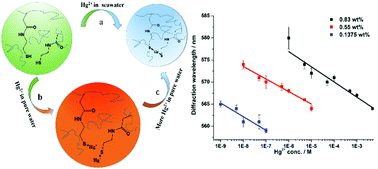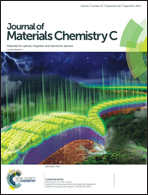Fabrication of intelligent photonic crystal hydrogel sensors for selective detection of trace mercury ions in seawater†
Abstract
A hydrogel sensing material has been fabricated using three dimensional (3-D), polymerized colloidal photonic crystals (PCPCs) for highly sensitive and selective detection of mercury ions (Hg2+) in seawater. Due a to periodically ordered lattice of the embedded photonic crystals, the hydrogel diffracts light in visible spectral range according to the Bragg's law. The hydrogel has been functionalized by spatially distributed –SH groups through cleaving –S–S– bonds in grafted N,N′-cystaminebisacrylamide molecules and can selectively bind with Hg2+ ions to form –S–Hg–S– bridge bonds in seawater. The Hg2+ binding causes the volume of the hydrogel to shrink, corresponding to a wavelength shift of the light diffracted by the hydrogel. The shifted wavelength is proportional to the amount of bound Hg2+ ions, which enables the quantitative evaluation of Hg2+ ions with a limit of detection at 10−9 M level in seawater, as measured by a portable spectrometer. With this intelligent hydrogel sensors, we demonstrate a simple method for the rapid in situ monitoring and detection of Hg2+ ions at low concentrations in seawater.



 Please wait while we load your content...
Please wait while we load your content...